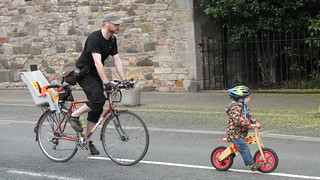"sitting in a car going from dumb box to dumb box not only leaves us disconnected but it's not even the future for business"
I need to get link to article in today's Herald.
Needless to say the idea of taxing out of town retailers has met some opposition. Architect Malcolm Fraser's new role is chair of the Scottish Government's National Review of Town Centres.
CityCyclingEdinburgh Forum » Infrastructure
Malcolm Fraser declares war on out-of-town retail ... Herald
(28 posts)-
Posted 12 years ago #
-
also in
http://www.scotsman.com/news/cultural-rebirth-to-help-revive-scotland-s-high-streets-1-2515035Posted 12 years ago # -
"The Government's guidance to planning authorities already emphasises the need to ensure that planning decisions do not damage the vitality and viability of town centres as a whole. It will continue to stress this need" - This Common Inheritance, page 115, UK Government, September 1990.
1990!
Good luck Malcolm in actually achieveing something - because you are going to need it.
Posted 12 years ago # -
"
In Scotland, we await the publication of the National Review of Town Centres. And that difference in terminology between High Streets and town centres is, I think, quite significant."
Posted 12 years ago # -
"
Essay of the week: Rebuilding a place called home
Published on 7 July 2013By Malcolm Fraser. (EXTRACTS)
THERE is a disconnect in our lives, between the places we like – spend our holidays in, go on city-breaks to, feel energised by – and the everyday, post-war built environment we have grown used to, stuck in our cars, going from suburb to business park, to the retail park for the shopping then back to the suburb for tea and off to the out-of-town multiplex in the evening, each time driving round or through our old town centres, watching then turn from places we like – places that matter to us – into places that struggle without us.
...
Im lucky. I live in an old community and walk or cycle through the park to work. (My shops are nearby, entertainment too.) I get rained on sometimes and occasionally even sunned on; I hear the birdies and see the trees and say hello to friends. And, on occasion, one of them tells me something helpful – to my advantage in my work. So I arrive at the office healthier, happier and maybe even a wee bit more business-like.
It's a nice corner of town that I live in, but the principles that work for me, of nearness and amenity, work anywhere, and save me money – never mind all the lucrative things I can do with the time spent not sitting in traffic.
I'm far from alone in recognising this. In fact, there's a huge amount of activity around a number of urban-centred ideas, such as recognition that cities are the nation's creative and economic powerhouses; or that the ideals of community and heritage that towns embody need recovered; or – and this crucial aspect is less recognised – that in pursuing a low-carbon economy and fighting climate change, the "eco-town" title that is spun by those marketing new, car-dependant suburbs built on farmland, really should apply to the nearby, existing (but struggling) towns, from which the new developments aim to suck middle-class money.
It's our existing communities, with their infrastructure of roads, drains, schools and transport – and people – that are our eco-towns, our true, sustainable communities. And we might also note that a society based on the car excludes those who lack one, so that towns, with their public transport and their walkability, represent accessibility for all.
But maybe the tide has turned, and we are coming to understand that the post-war vision of a built environment seen exclusively through a car windscreen has run its course; and if we knit together these ideals – of creativity, community and sustainability – we could replace it by a vision of the future which emphasises some old, homespun urban virtues.
...
The full report can be read at: http://www.scotland.gov.uk/Resource/0042/00426972.pdf
"
Posted 12 years ago # -
A decent report, although it doesn't highlight anything that hasn't been known for many years. It is sadly let down by its recommendations - which are timid and broad enough to let the Scottish Government say that they are doing all this already and nicely tee up an announcement of a very modest fund for a "demonstration town centre" and further "research". Job done - no change. No disrespect to Malcolm Fraser - I'm sure he is perfectly aware of all this.
Posted 12 years ago # -
Combine this with Spokes' cycle-friendly towns and you might get somewhere.
Posted 12 years ago # -
From the report -
"
But we do recognise a wider context. Issues such as climate change and food security, and social and employment policies impact on the culture and viability of town centres. A strengthening of local democracy in Scotland would greatly assist with local leadership. Issues around business rates revaluation, and the need for financial institutions to reassess the value of their town centre properties, impact in a major way as well, and there is no doubt that a simple market re-adjustment would greatly assist town centre renewal. And the iniquity of the VAT system, whereby a new-build in a field on the edge of town is publicly-subsidised by being excused VAT, while
the repair of an existing building is burdened with the full 20%, is a formal UK-wide encouragement that squanders our resources, by hugely disadvantaging the old buildings and existing town centres at the heart of our communities....
Scotland’s town centres benefit hugely from the culture and enterprise their communities bring to them. On the one hand there are social enterprises starting-up and running commercial projects and services, such as nurseries, community bakeries, arts and crafts studios, community festivals and farmers’ and other sorts of markets. On the other, a great many of the 350 annual arts festivals which so engage and enliven Scotland are community-based and located in town centres, bringing bustle and money, as well as culture, into them. In any case, the year-round artistic activity of dance, music and general arts activities brings huge activity to town centres and
all these initiatives will be given new access to public sector assets by the drive towards “community empowerment”. The nurturing and enabling of existing and
new community activity, through collaboration with and between public and private agencies, brings huge possibilities for an increase in health, wealth and wellbeing in the population in general, as in our town centres....
Key Actions:
Town Centre WiFi: Commercially-driven, secure link-ups of town centre businesses’ WiFis, so that they combine to offer a shopper, or general visitor, free and immediate access to a virtual town centre marketplace from the comfort of the corner seat in a café, or a bench in the park on a sunny day....
Pro-active Planning
Planning policy for town centres should be simple and proactive, encouraging public, private and social enterprises to be creative in how they create and retain jobs, support the local community, support town centre living, contribute to creating a sustainable, low-carbon environment and realise locally agreed vision and plans. Accessibility is key and infrastructure should be designed to promote more walking, cycling and efficient public transportation provision and usage....
Key Action:
Town Futures/Planning for Change: this Review seeks a new narrative for our towns, with communities fully engaged and involved in forming it. We believe
they would greatly benefit from a “Masterplanning Toolkit” to implement their vision, that is complementary to the town-centred, pedestrian-friendly Scottish Government “Designing Streets” planning policy, which has set-out the culture-shift necessary to change the post-war roads presumption to a 21st century people one.
Such a “toolkit” would, first, give guidance on how a community might organise itself to evolve that vision and seek assistance in implementing it.
Second, it would outline responses to issues such as urban car parking, car clubs, congestion charging, bypasses, bus lanes, 20 mph zones, bicycles and powered 2-wheelers, pedestrianisation, pavements, urban trees, sheltered high streets, signage, urban clutter and other town-centred physical initiatives, in order to demonstrate a range of responses to the challenges town centres face and the opportunities change offers....
Posted 12 years ago # -
I think what is needed here is for an enlightened chamber of commerce somewhere to be demanding these sorts of measures. The question is finding one - maybe in one of those towns that is fighting off out of town supermarkets (if there are any left in Scotland)
Posted 12 years ago # -
Some people might think that the local MSP getting campaign donations from the guy behind Silverburn shopping centre in Pollock might bear examination. The body in charge decided that there was no intentional wrong doing. Now Paisley is a ghost town.
Posted 12 years ago # -
Posted 11 years ago #
-
Town Centre Action Plan published: http://www.scotland.gov.uk/Topics/Built-Environment/regeneration/town-centres/review.
Posted 11 years ago # -
Two of the photos on the above link of what I assume is the aspirational Scottish town centre include cycling. One a race and the other looks like a typical European people-and-cyle-friendly market town square.
From the report'
Accessibility is key and infrastructure should be designed to promote more walking, cycling and efficient public transportation provision and usage.and
We believe they would greatly benefit from a “Masterplanning Toolkit” to implement their vision, that is complementary to the town-centred, pedestrian-friendly Scottish Government “Designing Streets” planning policy, which has set-out the culture-shift
necessary to change the post-war roads presumption to a 21st century people one.Not much (anything) about building new roads, de-pedestrianisation and free parking for all and everywhere.
Posted 11 years ago # -
What's this? £2m for a demonstration project, further research, more joint working. If only I could have predicted such an outcome about four months ago.
Posted 11 years ago # -
"
We are delighted that there is included an emphasis on strengthening town centres, including a ‘town centre first’ approach for a wider range of uses. However we are very dismayed that this is not supported by more emphasis on the creation of environments which will encourage and facilitate Active Travel. Much recent research has provided evidence of the value of pedestrian and cyclist custom to services, and we feel this has been overlooked in this document.
"
http://www.spokes.org.uk/wordpress/wp-content/uploads/2012/09/1311-letter-to-Derek-Mackay-v3.pdf
Posted 11 years ago # -
So Keith Brown agreed with Spokes proposal but then ignored it? Sounds familiar.
It is just such a no brainer I have difficulty getting my head round it. The less money you give to oil multinationals, the more you have to spend in the shops. Duh.
Plus, motorised shoppers only ever buy washing machines. If we don't want high streets with washing machine purveyors and nothing else, we need to act surely?
Posted 11 years ago # -
"Inverness is the city with the greatest number of empty shops as a percentage of total premises at 65 per cent – due to a propensity for out-of-town offices, compared to Aberdeen, which has just 58.5 per cent."
Clearly the answer to this is to spent billions building a bypass around Aberdeen, dualling the A9 to Inverness, and dualling the A96 between the two cities. Thereby making it easier for motorists to never have to visit the city centres, and get to out of town retailers more quickly and efficiently, er.....well the A96 upgrade will help sort this out: "small towns such as Banff and Huntly have vacancy rates in excess of 30 per cent." Because folk in those towns will be able to drive to the big out of town places on the outskirts of Inverness and Aberdeen more easily, er...
Posted 11 years ago # -
Not forgetting of course the impact of the internet on retail. We can buy anything at all from our sofas, so a city center shop has to offer something extraordinary beyond the merchandise. This could be a sense of community or expert advice, but it's always going to be expensive. Think of the Edinburgh bike shops that have survived and those that have sunk. Basic merchandise and grudging service correlate well with businesses which are no longer running.
Unless a city center shop is somewhere you actively want to go to it won't survive long these days.
Posted 10 years ago # -
I have just had the mispleasure of being at that retail black-hole-for-the-soul that is the Gyle. Notable how many empty units there are, or units filled with temporary fly-by-night sort of operations like E-cigarettes or Christmas-only
gadgetjunk shops, or little stands purporting to be "luxury nail bars" or flogging double glazing. The appeal of internet shopping is immense when faced with venues like this. That and nearly getting wiped out on the bike twice in the confines of the car park by racing overtakers or non-indicatorists.Posted 10 years ago # -
Radio phone-in this morning had three small retailers talking about how to make their businesses more profitable. Consensus was reached that you can't get enough car parking. (That's true in negative way as USA has proven).
The retail expert on the programme thought that the parking argument was bogus (but experts rarely run shops!). Parking is one factor that can be affected by lobbying so businesses do like to maximise it. But in reality most businesses were only yards away from a car park. Of course cost is one thing but no-one seems to estimate their own time sat in a car.
Inverurie apparently is successful despite congestion. One retailer admitted that some people actually walked or cycled to their shop! Unless someone opens a drive in hair dressers that might continue...
Posted 10 years ago # -
65% of Inverness' retail space is empty? Aberdeen 59%. Ah hae me doots.
Posted 10 years ago # -
"
But the scheme has been dropped for this year, leaving motorists to pay the full cost of parking if they choose to drive into the centre to do their Christmas shopping or visit the festive attractions.
However, city centre businesses accepted the scheme had not been a key factor in attracting people into town.
Andy Neal, chief executive of Essential Edinburgh, which operates the city-centre business improvement district, said surveys showed free parking was not the crucial issue for people.
"
http://citycyclingedinburgh.info/bbpress/topic.php?id=11446&replies=4#post-174416
Posted 10 years ago # -
"
Nick Barley (@nickbarleyedin)
08/12/2014 19:39
Malcolm Fraser at #DesireLinesEdin 'there is an enormous amount of money sloshing around in Scotland. We need proper taxation.'"
https://twitter.com/nickbarleyedin/status/542040778785452033
Posted 10 years ago # -
"
When the architect Malcolm Fraser began to speak about the tremendous drama and beauty of Edinburgh’s cityscape, and to show a few pictures of it on screen, the crowd looked as if they might break into spontaneous applause
"
http://www.scotsman.com/news/joyce-macmillan-path-to-change-lined-with-desire-1-3632394
Posted 10 years ago #
Reply
You must log in to post.

 posts
posts
